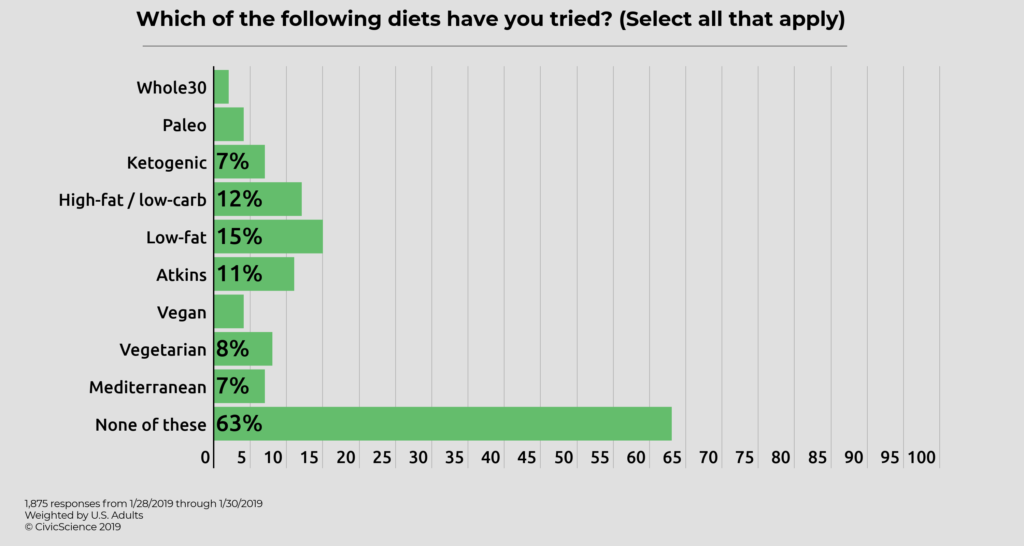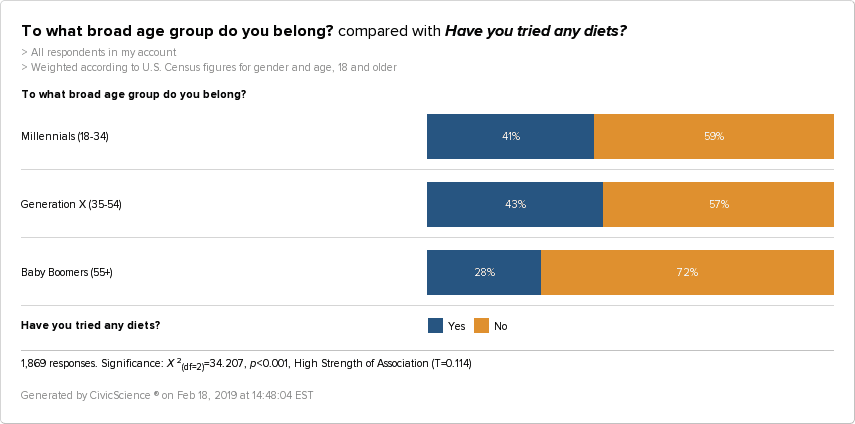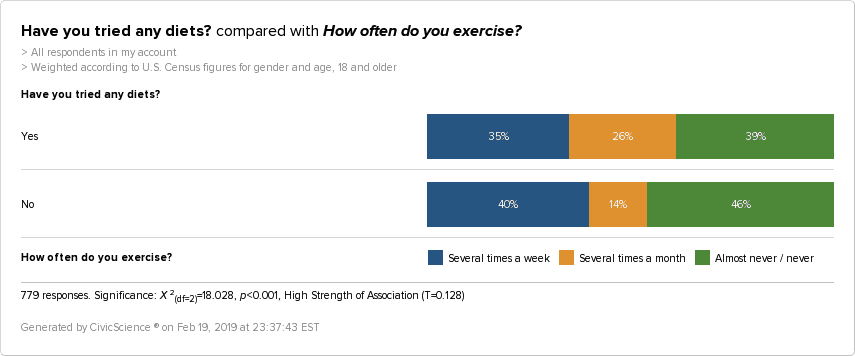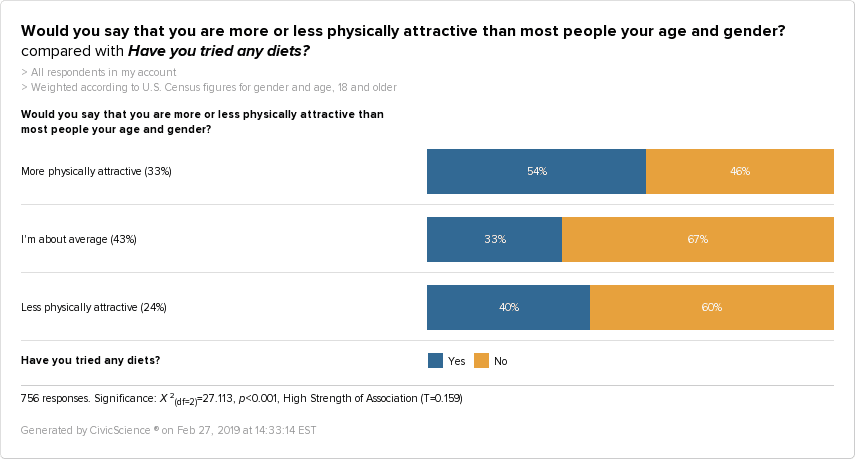Diet trends and fads are nothing new to the American cultural landscape. Over the years, countless diet and fitness trends have emerged with the promise to maximize weight loss, minimize common health issues, and kickstart a healthy life with a new and improved you. While we’ve seen some come and go, a few have stuck around, even as new diets continue to emerge and create a splash in the world of health and fitness. CivicScience studied the continuous cycle of diet trends by asking over 1,800 U.S. adults about their experiences.
Respondents were asked to identify all of the following 9 diets they had tried. In doing so, CivicScience found that 37% of U.S. adults polled have tried at least one fad diet. The data show that Low fat, High-fat / low-carb, and the Atkins diets were most popular, respectively. On the lower end of popularity were Whole30, Vegan, and Paleo diets.
The Atkins Diet (low-carb) vs. A Low-Fat Diet
The Atkins diet is a classic among fad diets. It is a low-carb diet that cuts out excessive carbohydrates (sugars) and focuses on weight-loss as its primary goal. The Atkins diet has been around for many years and results show that 11% of dieters have tried it.
Still, the more standard, non-branded low-fat diet performed best overall in terms of popularity, showing 15% of dieters giving it a try.
Both the Atkins and low-fat diets showed to be the most popular among the 35-44-year-old age group. 29% of this age group had tried the Atkins diet, while a slightly smaller 27% had tried a low-fat diet.
There was also a good bit of overlap between these two diets: 38% of those who have tried Atkins have also tried a low-fat diet.
High-Fat / Low-Carb vs. The Ketogenic Diet
While there are many similarities between these two diets, 12% of respondents have tried the High-fat / low-carb diet, while only 7% of folks reported having tried the Ketogenic, or “Keto” diet, the branded version of this diet.
Though only a little more than half as many respondents have tried the Keto diet compared to its generic High-fat / low-carb counterpart, the Keto diet is still most popular among the newer fad diets polled (Keto, Paleo, Whole30).
The Keto diet has been making waves throughout the diet and fitness world, with many blogs and social media pages dedicated to sharing the benefits individuals have experienced from following the diet. Time on those social media pages or accounts appears to be aplenty: those who have tried the Keto diet spend significantly more time on social media sites and apps than non-Keto dieters.
Because of the similarities between Keto and high-fat / low-carb diets, participants do show some overlap, with 31% of those who have tried a generic high-fat / low-carb diet also indicating they have tried the Keto diet.
CivicScience also found that the non-branded high-fat / low-carb diet is most popular with 25-34-year-olds (16% have tried) as well as with the Ketogenic diet (10%).
Not a Whole Lot Have Tried Whole30
Whole30 is a clean eating program that cuts out alcohol, sugar, grains, legumes, dairy, and additives from the diet for 30 days. Though Whole30 has seemed to have quite a bit of buzz over the last year or so, it proved to have the least amount of buzz among our sample. A slim 2% of respondents have tried the diet.
Though it is least popular in our overall sample, Whole30 dieters are more likely to be Millennials.
Battle of the Sexes
When it comes to gender and dieting, women are 51% more likely to diet (44%) than their male counterparts (29%).
Younger People Are More Likely to Diet
No matter what age you are, health, outward appearance, or likely a combination of the two, are important factors in determining how interested we are in dieting. As shown below, a good portion of folks across all age ranges has dieted in some capacity. Least likely were those 55+, while most likely to diet were Gen Xers, followed by Millennials.
Non-dieters Exercise More Frequently
Diet and exercise go hand-in-hand for many people who are on a mission to lose weight and get healthy. Some diets are designed and/or recommended to be followed in addition to regular exercise, so which diets are dieters most likely to pair with regular exercise?
The information gathered shows that many people are, in fact, exercising in addition to dieting. Most likely to exercise regularly were vegan and Whole30 dieters – 76% of vegans and 75% of Whole30 dieters reported exercising several times a week. Paleo dieters were also likely to exercise several times a week, with 59% reporting as such. Due to the high protein intake of the Paleo diet and its high levels of recommended physical activity, this is no surprise. On the other hand, the Atkins diet was least likely to be paired with regular exercise, having only 31% of dieters exercising several times a week.
Of the non-dieters, 40% reported that even though they aren’t dieting, they are still exercising several times a week. This means, overall, the dieters polled are exercising less frequently than non-dieters, with only 35% reporting to exercise several times a week.
Perception of Appearance Factors In
Lastly, those who consider themselves more physically attractive are the most likely to have tried dieting, while those who consider themselves ‘average’ are the least likely to have dieted.
Following a specific diet isn’t for everyone. While the majority of the population has not tried any of these commonly known or trendy diets, the data show that some old standards like low-fat or low-carb are most popular, but high-fat diets are gaining popularity.
















